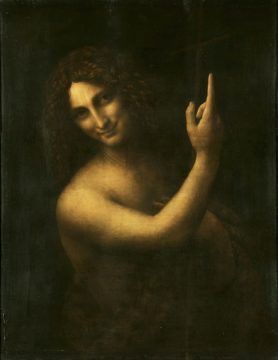Christian Kleinbub at The Brooklyn Rail:
 In the popular imagination, the name Leonardo da Vinci conjures many things. In traditional textbooks, he epitomizes the concept of the “Renaissance man,” capable of knowing and doing everything. Another view has it that he was a prototypical engineer and scientist—inventor of tanks, helicopters, self-perpetuating machines, and urban infrastructure—and thus the forerunner of much of what we deem essential in our supposedly secular, technology-driven world. Art historians generally describe him as the key figure in a new phase in European painting, attuned to the portrayal of psychology and the subjectivity of sight, all while exercising an unparalleled naturalism. But, despite these things, there has always been another image of Leonardo, one that associated him with hidden things, esoteric knowledge beyond common perceptions. In Dan Brown’s The Da Vinci Code (2003), Leonardo figures as a guardian of a forbidden secret, keeping alive the dangerous knowledge that Christ married Mary Magdalene and had a child by her. In the context of Brown’s thriller, Leonardo is a knower of the unknown, a keeper of truths that must remain encrypted by means of his famous mirror writing. Because Leonardo’s secret could potentially overturn orthodox Christian beliefs, his perpetuation of it paradoxically meshes with his reputation as a harbinger of the modern world. Like a Nostradamus, he anticipates history, hiding the keys to understanding things that are beyond the grasp of his contemporaries and a challenge for more enlightened ages.
In the popular imagination, the name Leonardo da Vinci conjures many things. In traditional textbooks, he epitomizes the concept of the “Renaissance man,” capable of knowing and doing everything. Another view has it that he was a prototypical engineer and scientist—inventor of tanks, helicopters, self-perpetuating machines, and urban infrastructure—and thus the forerunner of much of what we deem essential in our supposedly secular, technology-driven world. Art historians generally describe him as the key figure in a new phase in European painting, attuned to the portrayal of psychology and the subjectivity of sight, all while exercising an unparalleled naturalism. But, despite these things, there has always been another image of Leonardo, one that associated him with hidden things, esoteric knowledge beyond common perceptions. In Dan Brown’s The Da Vinci Code (2003), Leonardo figures as a guardian of a forbidden secret, keeping alive the dangerous knowledge that Christ married Mary Magdalene and had a child by her. In the context of Brown’s thriller, Leonardo is a knower of the unknown, a keeper of truths that must remain encrypted by means of his famous mirror writing. Because Leonardo’s secret could potentially overturn orthodox Christian beliefs, his perpetuation of it paradoxically meshes with his reputation as a harbinger of the modern world. Like a Nostradamus, he anticipates history, hiding the keys to understanding things that are beyond the grasp of his contemporaries and a challenge for more enlightened ages.
more here.
